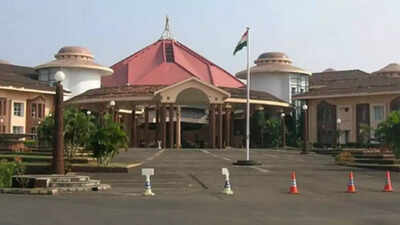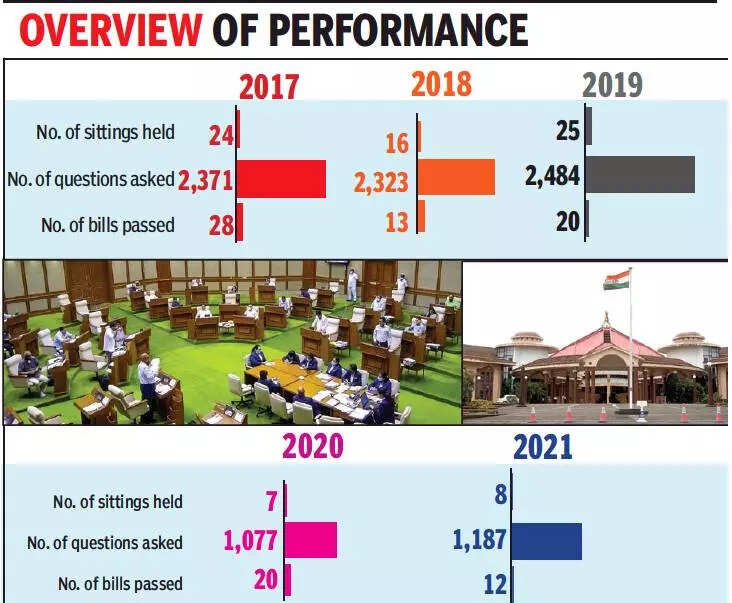Since 2017, Goa assembly sat for average 16 days in a year: ADR
Since 2017, Goa assembly sat for average 16 days in a year: ADR

<p>The report shows that the duration of the state legislative assembly has been on a decline since 2017, with the number of sittings declining from 24 days in 2017 to eight days in 2021. <br></p>
PANAJI: In the past five years, Goa’s 40 elected lawmakers worked for an average of just 16 days a year. A detailed performance report by the Association of Democratic Reforms (ADR) highlights the plummeting graph of the Goa legislative assembly since 2017, with the House often meeting for a single day to meet Constitutional obligations.
The report also shows that of the 40 MLAs, just 11 participated in the business of the house every single day out of the 80 days that the House functioned. Ministers are not required to mark their attendance. Congress MLAs Aleixo Reginaldo Lourenco and Digambar Kamat asked the most questions. Most of the questions revolved around water supply, panchayats and rural development, and education.

“Many want to know whether this track record of 16 days is good or bad,” said ADR representative Bhasker Assoldekar. “I would suggest, compare it with the 312 days the 16th Lok Sabha sat in five years from 2014, which is almost 62 days in a year against the Goa assembly’s 16. (This was) perhaps partly due to Covid-19.”
The report shows that the duration of the state legislative assembly has been on a decline since 2017, with the number of sittings declining from 24 days in 2017 to eight days in 2021. The number of bills passed by the lawmakers also saw a corresponding decline from 28 in 2017 to 12 in 2021.
The longest session was from July 15 to August 9, 2019. The House met for just a single day on four different occasions. In 2018, well before the Covid-19 pandemic, the House was convened just twice for a total period of 16 days, indicating the BJP government’s move to skirt legislative debates in the state assembly.
The Constitution does not stipulate the number of days that a legislative assembly should meet, but does state that not more than six months should pass between sessions.
The report also shows that of the 40 MLAs, just 11 participated in the business of the house every single day out of the 80 days that the House functioned. Ministers are not required to mark their attendance. Congress MLAs Aleixo Reginaldo Lourenco and Digambar Kamat asked the most questions. Most of the questions revolved around water supply, panchayats and rural development, and education.

“Many want to know whether this track record of 16 days is good or bad,” said ADR representative Bhasker Assoldekar. “I would suggest, compare it with the 312 days the 16th Lok Sabha sat in five years from 2014, which is almost 62 days in a year against the Goa assembly’s 16. (This was) perhaps partly due to Covid-19.”
The report shows that the duration of the state legislative assembly has been on a decline since 2017, with the number of sittings declining from 24 days in 2017 to eight days in 2021. The number of bills passed by the lawmakers also saw a corresponding decline from 28 in 2017 to 12 in 2021.
The longest session was from July 15 to August 9, 2019. The House met for just a single day on four different occasions. In 2018, well before the Covid-19 pandemic, the House was convened just twice for a total period of 16 days, indicating the BJP government’s move to skirt legislative debates in the state assembly.
The Constitution does not stipulate the number of days that a legislative assembly should meet, but does state that not more than six months should pass between sessions.
FacebookTwitterLinkedinEMail
Start a Conversation
end of article
Quick Links
Delhi Air PollutionDelhi TemperatureChennai WeatherBangalore TemperatureCovid vaccination centres in DelhiCoronavirus in DelhiRTPCR test in GurgaonHyderabad RainPollution level in BangaloreDelhi SmogDelhi TemperatureNoida AQIGurgaon AQI todayFire in MumbaiMumbai RainsCovid 19 RT PCR Test in NoidaDelhi AQI todaySrinagar encounter

